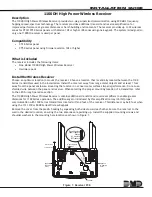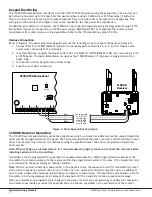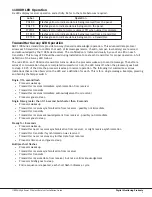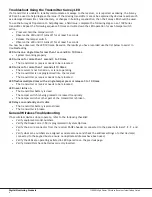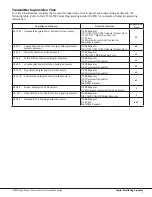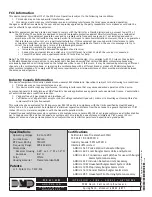
8 0 0 - 6 4 1 - 4 2 8 2
I N T R U S I O N • F I R E • A C C E S S • N E T W O R K S
w w w . d m p . c o m
2 5 0 0 N o r t h P a r t n e r s h i p B o u l e v a r d
Designed, Engineered and
Assembled in U.S.A.
S p r i n g fi e l d , M i s s o u r i 6 5 8 0 3 - 8 8 7 7
LT
-0969 1.06 © 2017 Digital Monitoring P
roducts, Inc.
17451
Certifications
California State Fire Marshal (CSFM)
FCC Part 15: CCKPC0114
Industry Canada: 5251A-PC0114
Intertek (ETL) Listed
ANSI/UL 365 Police Station Connected Burglar
ANSI/UL 609 Local Burglar Alarm Units and Systems
ANSI/UL 634 Connections and Switches for use with Burglar
Alarm Systems Accessory
ANSI/UL 639 Intrusion Detection Units Accessory
ANSI/UL 1023 Household Burglar Alarm System Units
ANSI/UL 1076 Proprietary Burglar Alarm Units
ANSI/UL 1610 Central Station Burglar Alarm Units
ANSI/UL 985 Household Fire Warning System Accessory
Specifications
Operating Voltage
8.0 to 14VDC
Current Draw
240mA
RF Power Rating
720mW
Frequency Range 905-924 MHz
Dimensions
Receiver Housing 4.65” L x 3.1” W x 1.4” H
Antennas
8.6” H
Color
White
Housing Material
Flame retardant ABS
Patents
U. S. Patent No. 7,239,236
FCC Information
This device complies with Part 15 of the FCC Rules. Operation is subject to the following two conditions:
1. This device may not cause harmful interference, and
2. this device must accept any interference received, including interference that may cause undesired operation.
Changes or modifications made by the user and not expressly approved by the party responsible for compliance could void the
user’s authority to operate the equipment.
Note: This equipment has been tested and found to comply with the limits for a Class B digital device, pursuant to part 15 of
the FCC Rules. These limits are designed to provide reasonable protection against harmful interference in a residential
installation. This equipment generates, uses and can radiate radio frequency energy and, if not installed and used in
accordance with the instructions, may cause harmful interference to radio communications. However, there is no guarantee
that interference will not occur in a particular installation. If this equipment does cause harmful interference to radio
or television reception, which can be determined by turning the equipment off and on, the user is encouraged to try to
correct the interference by one or more of the following measures:
• Reorient or relocate the receiving antenna.
• Increase the separation between the equipment and receiver.
• Connect the equipment into an outlet on a circuit different from that to which the receiver is connected.
• Consult the dealer or an experienced radio/TV technician for help.
Note: The 1100 Series wireless system is a two-way supervised wireless design. It is compliant with FCC rules as they pertain
to 900 MHz Spread Spectrum devices. In rare instances it has been observed that certain 900 MHz cordless telephones may
occasionally experience a clicking sound on the telephone while in use. If this occurs, it may be resolved by selecting a different
channel on the cordless telephone, or replacing the cordless phone with a different brand or model of 900 MHz telephone or
other cordless telephone. To comply with RF exposure requirements, a minimum distance of 20cm must be maintained between
the antenna and all persons.
Industry Canada Information
This device complies with Industry Canada Licence-exempt RSS standard(s). Operation is subject to the following two conditions:
1. This device may not cause interference, and
2. this device must accept any interference, including interference that may cause undesired operation of the device.
Le présent appareil est conforme aux CNR d’Industrie Canada applicables aux appareils radio exempts de licence. L’exploitation
est autorisée aux deux conditions suivantes:
1. l’appareil ne doit pas produire de brouillage, et
2. l’utilisateur de l’appareil doit accepter tout brouillage radioélectrique subi, même si le brouillage est susceptible d’en
compromettre le fonctionnement.
This system has been evaluated for RF Exposure per RSS-102 and is in compliance with the limits specified by Health Canada
Safety Code 6. The system must be installed at a minimum separation distance from the antenna to a general bystander of 7.87
inches (20 cm) to maintain compliance with the General Population limits.
L’exposition aux radiofréquences de ce système a été évaluée selon la norme RSS-102 et est jugée conforme aux limites établies
par le Code de sécurité 6 de Santé Canada. Le système doit être installé à une distance minimale de 7.87 pouces (20 cm)
séparant l’antenne d’une personne présente en conformité avec les limites permises d’exposition du grand public.

